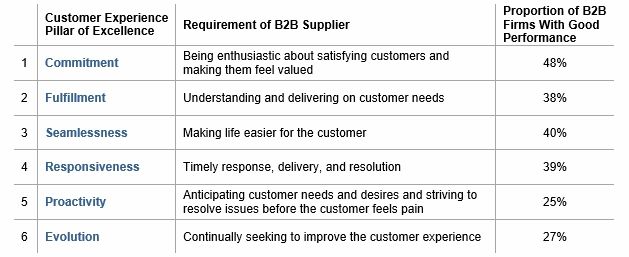
There is substantial evidence correlating positive customer experience with business growth.
Most customers spend more as a result of a positive customer experience, and more than half of customers who recommend a brand do so because of the customer experience (versus other factors, such as price or product), research has found.
However, many companies fail to deliver excellent customer experience.
Yet, poor customer experience drives brand switching—typically a key reason for three quarters of lost customers. And most customers who suffer a bad customer experience spread negative word-of-mouth.

1. Commitment
The first step in customer experience excellence is to be committed to satisfying customers and making them feel valued. Without that commitment across the company, it is significantly more difficult to succeed on the remaining pillars of customer experience excellence.
Only around a half of business are committed—again, highlighting the opportunity for companies to differentiate through customer-centricity.
2. Fulfillment
Many business are guilty of selling products and services that they want to sell, rather than what the customer really wants and values. Rightly, then, the next pillar of customer experience excellence relates to understanding and delivering on customer needs.
It is somewhat worrying that only 38% of business perform well on this important requirement, indicating a need for companies to better align their offering with customer wants and desires.
3. Seamlessness
A company may deliver valued products and services, but how does the customer perceive the entire journey, from registering the need to receiving the final deliverable?
Across hundreds of brands, a key driver of overall satisfaction and loyalty is ease of doing business with the supplier. Whether it’s a manufacturing company, a reseller or a financial services supplier, seamlessness is vital to a successful customer experience.
Seamlessness, therefore, makes it into the top six customer experience excellence pillars, but only 4 in 10 business perform well in this regard.
4. Responsiveness
Central to customer-centricity is making customers feel that they are the most important customer being served, and responsiveness goes a long way toward demonstrating to customers that they are valued.
Responsiveness is a critical customer experience excellence pillar that spans touchpoints across the customer journey, such as communications, deliveries, and issue resolution.
Failing on this important requirement can increase customer defection, and so it is alarming that only 39% of business perform well on responsiveness.
5. Proactivity
The more sophisticated customer-centric businesses are those that are proactive in delivering a superior customer experience. Such firms anticipate customer needs and desires, and strive to resolve issues before the customer feels pain. Doing so requires the supplier to walk in the customer’s shoes to foresee potential customer needs and pain points and to be fully prepared for them. A mere quarter of business admit to performing well on proactivity.
6. Evolution
The final pillar, evolution, describes the totally customer-centric firm that recognizing it must always make improvements to the customer experience because customer needs, attitudes, and behaviors change over time.
Just 27% of business say they perform well on this continual-improvement process; nearly three-fourths of companies therefore acknowledge their weakness in not addressing the customer experience on an ongoing basis.
